MAZDA 626 1987 Workshop Manual
Manufacturer: MAZDA, Model Year: 1987, Model line: 626, Model: MAZDA 626 1987Pages: 1865, PDF Size: 94.35 MB
Page 781 of 1865
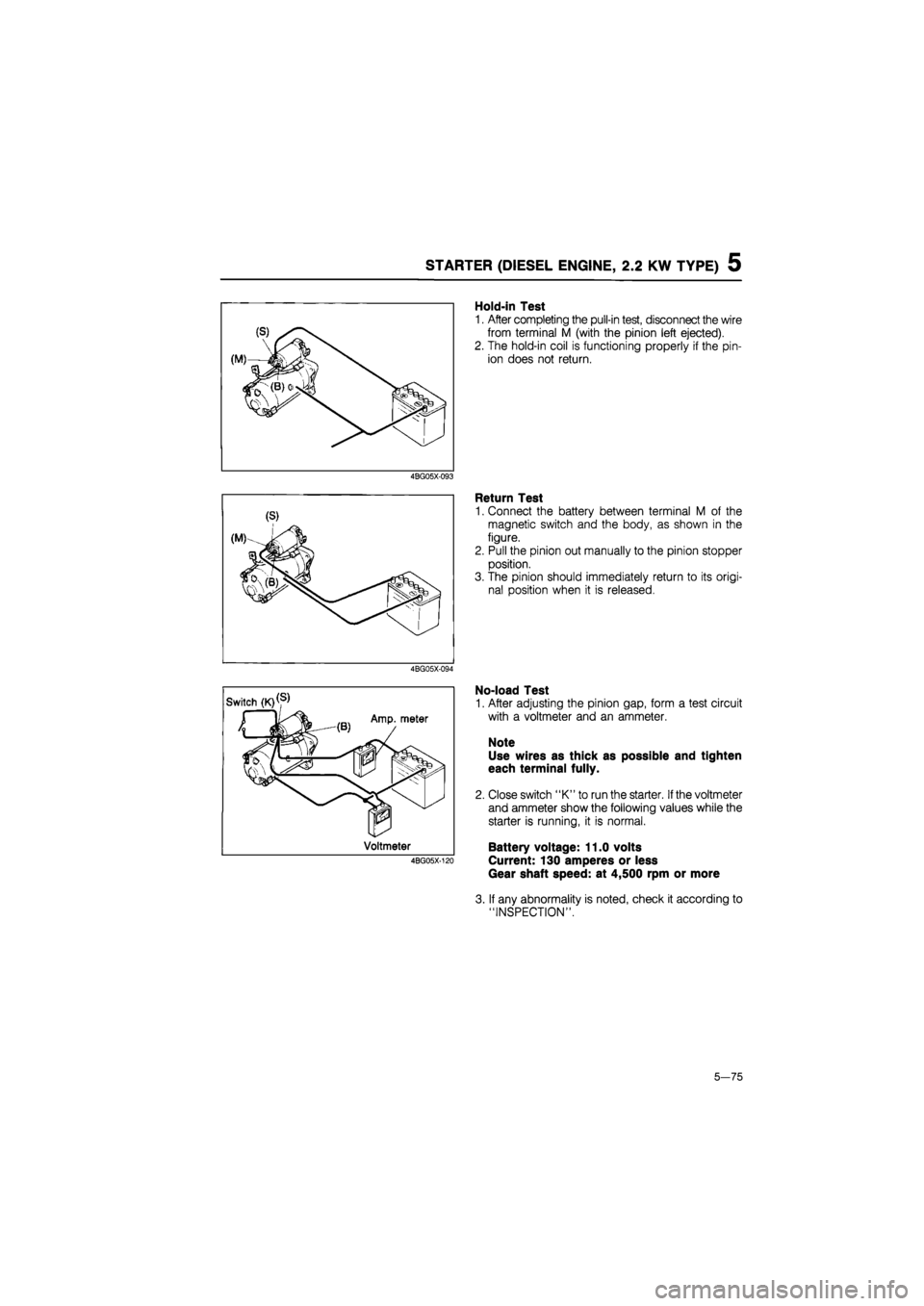
5 STARTER (DIESEL ENGINE, 2.0 KW TYPE)
Hold-in Test
1. After completing the pull-in test, disconnect the wire
from terminal M (with the pinion left ejected).
2. The hold-in coil is functioning properly if the pin-
ion does not return.
4BG05X-093
Return Test
1. Connect the battery between terminal M of the
magnetic switch and the body, as shown in the
figure.
2. Pull the pinion out manually to the pinion stopper
position.
3. The pinion should immediately return to its origi-
nal position when it is released.
4BG05X-094
No-load Test
1. After adjusting the pinion gap, form a test circuit
with a voltmeter and an ammeter.
Note
Use wires as thick as possible and tighten
each terminal fully.
2. Close switch "K" to run the starter.
If
the voltmeter
and ammeter show the following values while the
starter is running, it is normal.
Battery voltage: 11.0 volts
Current: 130 amperes or less
Gear shaft speed: at 4,500 rpm or more
3. If any abnormality is noted, check it according to
"INSPECTION".
5—75
Page 782 of 1865

5 QUICK START SYSTEM (QSS)
QUICK START SYSTEM (QSS)
COMPONENT LOCATION
76G05X-048
CIRCUIT DIAGRAM
76G05X-049
5—76
Page 783 of 1865
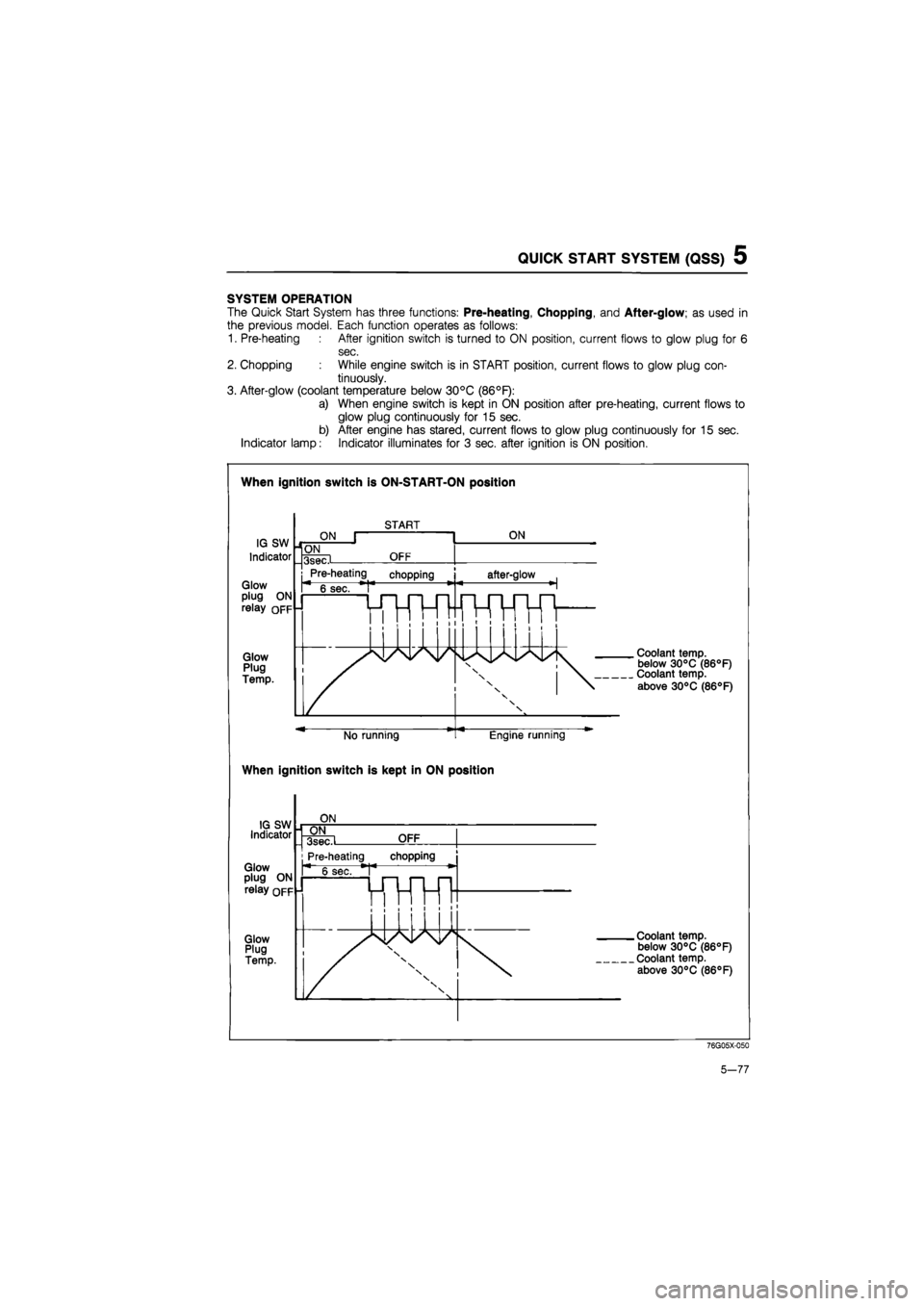
QUICK START SYSTEM (QSS) 5
SYSTEM OPERATION
The Quick Start System has three functions: Pre-heating, Chopping, and After-glow; as used in
the previous model. Each function operates as follows:
1. Pre-heating After ignition switch is turned to ON position, current flows to glow plug for 6
sec.
2. Chopping While engine switch is in START position, current flows to glow plug con-
tinuously.
3. After-glow (coolant temperature below 30°C (86°F):
a) When engine switch is kept in ON position after pre-heating, current flows to
glow plug continuously for 15 sec.
b) After engine has stared, current flows to glow plug continuously for 15 sec.
Indicator lamp: Indicator illuminates for 3 sec. after ignition is ON position.
When ignition switch is ON-START-ON position
When ignition switch is kept in ON position
76G05X-050
5-77
Page 784 of 1865
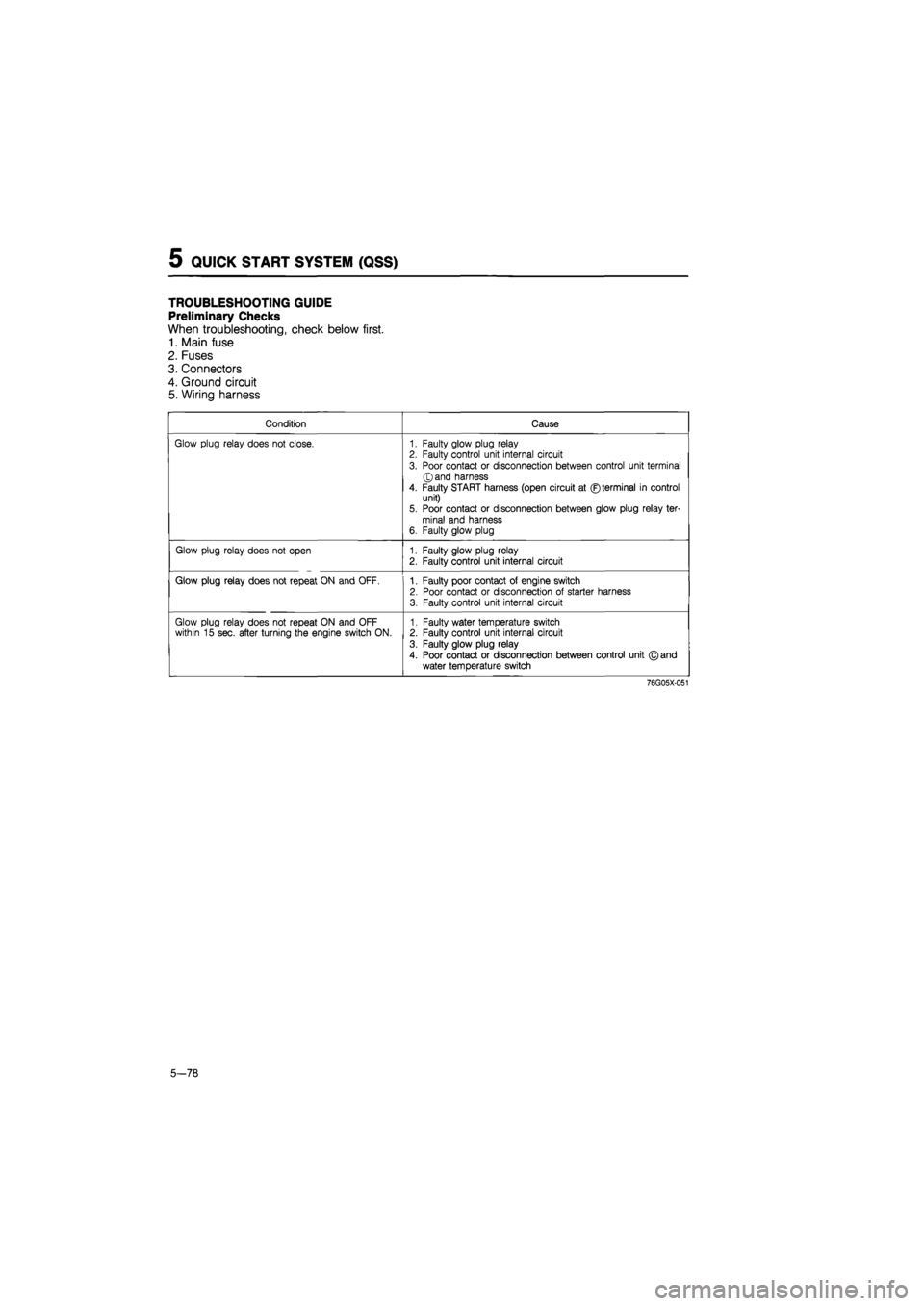
QUICK START SYSTEM (QSS) 5
TROUBLESHOOTING GUIDE
Preliminary Checks
When troubleshooting, check below first.
1. Main fuse
2. Fuses
3. Connectors
4. Ground circuit
5. Wiring harness
Condition Cause
Glow plug relay does not close. 1. Faulty glow plug relay 2. Faulty control unit internal circuit
3. Poor contact or disconnection between control unit terminal ©and harness
4. Faulty START harness (open circuit at ©terminal in control unit) 5. Poor contact or disconnection between glow plug relay ter-minal and harness 6. Faulty glow plug
Glow plug relay does not open 1. Faulty glow plug relay 2. Faulty control unit internal circuit
Glow plug relay does not repeat ON and OFF. 1. Faulty poor contact of engine switch 2. Poor contact or disconnection of starter harness 3. Faulty control unit internal circuit
Glow plug relay does not repeat ON and OFF within 15 sec. after turning the engine switch ON. 1. Faulty water temperature switch 2. Faulty control unit internal circuit
3. Faulty glow plug relay
4. Poor contact or disconnection between control unit © and water temperature switch
76G05X-051
5-78
Page 785 of 1865
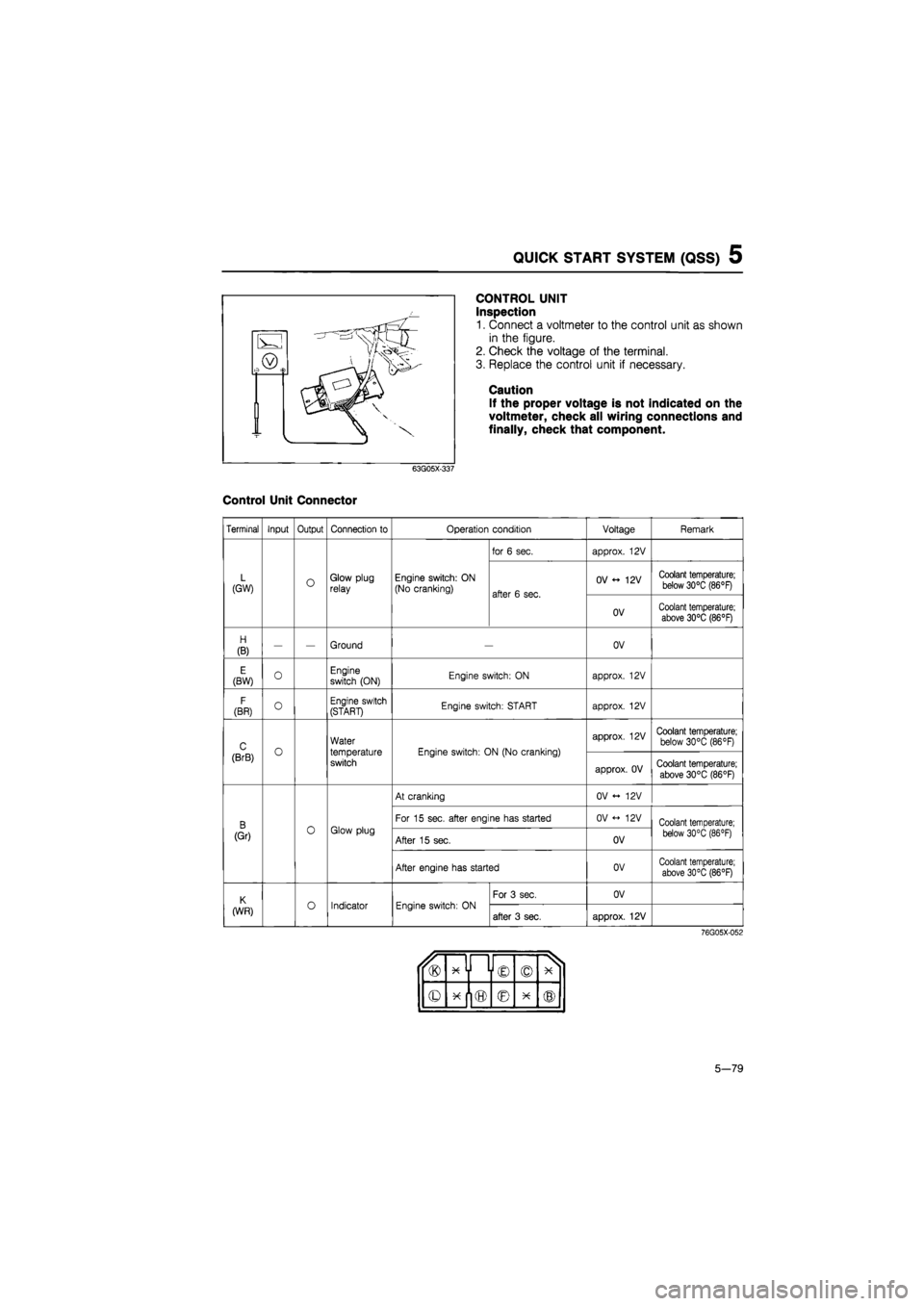
QUICK START SYSTEM (QSS) 5
CONTROL UNIT
Inspection
1. Connect a voltmeter to the control unit as shown
in the figure.
2. Check the voltage of the terminal.
3. Replace the control unit if necessary.
Caution
If the proper voltage is not indicated on the
voltmeter, check all wiring connections and
finally, check that component.
63G05X-337
Control Unit Connector
Terminal Input Output Connection to Operation condition Voltage Remark
for 6 sec. approx. 12V
L (GW) O Glow plug relay Engine switch: ON (No cranking) after 6 sec.
OV 12V Coolant temperature; below 30°C (86°F) after 6 sec.
OV Coolant temperature; above 30°C (86°F)
H
(B) — — Ground OV
E (BW) 0 Engine switch (ON) Engine switch: ON approx. 12V
F
(BR) O Engine switch (START) Engine switch: START approx. 12V
C o
Water
temperature switch
Engine switch: ON (No cranking)
approx. 12V Coolant temperature; below 30°C (86°F)
(BrB) o
Water
temperature switch
Engine switch: ON (No cranking)
approx. OV Coolant temperature;
above 30°C (86°F)
At cranking OV <- 12V
B 0 Glow plug
For 15 sec. after engine has started OV <-> 12V Coolant temperature;
(Gr) 0 Glow plug After 15 sec. OV below 30°C (86 °F)
After engine has started OV Coolant temperature; above 30°C (86°F)
K o Indicator Engine switch: ON
For 3 sec. OV
(WR) o Indicator Engine switch: ON after 3 sec. approx. 12V
76G05X-052
u® x y i © © X 1
© © X ®
5-79
Page 786 of 1865

5 QUICK START SYSTEM (QSS)
Glow plug relay GLOW PLUG RELAY
Inspection
1. As shown in the figure, connect the battery and
an ohmmeter to the relay.
2.
If
the ohmmeter shows continuity when the battery
is connected, and no continuity when the battery
is disconnected, the relay is good.
3. Replace the relay if it fails this test.
4BG05X-123
GLOW PLUG
Inspection
1. Check the continuity between the positive termi-
nal of the glow plug and cylinder head with a cir-
cuit tester.
2. If there is no continuity, replace the glow plug.
4BG05X-121
Removal
Remove in the following order:
1. Glow plug connector attaching nut.
2. Glow plug connector.
3. Glow plug
Installation
Install the glow plug, reverse order of removal.
76G05X-053
63G05X-336
5-80
WATER TEMPERATURE SWITCH
Removal
Remove the water temperature switch from the
radiator.
Installation
Install in the reverse order of removal.
Inspection
1. Place the water temperature switch in water with
a thermometer and heat the water gradually.
2. Check the temperature at which continuity exists
between the terminals.
3. Replace the switch, if necessary.
Specified temperature: above 28—32°C
(82—90°F)
Page 787 of 1865

CLUTCH
OUTLINE 6— 2
STRUCTURAL VIEW 6— 2
SPECIFICATIONS 6— 3
TROUBLESHOOTING GUIDE 6— 3
ON-VEHICLE MAINTENANCE 6— 4
FLUID LEVEL 6— 4
PEDAL HEIGHT 6— 4
PEDAL FREEPLAY 6— 4
CLUTCH PEDAL 6— 5
REMOVAL 6— 5
INSPECTION 6— 6
INSTALLATION 6— 6
ADJUSTMENT 6— 6
CLUTCH MASTER CYLINDER 6— 7
REMOVAL 6— 7
DISASSEMBLY 6—8
INSPECTION 6— 9
ASSEMBLY 6— 9
INSTALLATION 6—11
CLUTCH RELEASE CYLINDER 6—11
REMOVAL 6—12
DISASSEMBLY 6-12
INSPECTION 6—13
ASSEMBLY 6—13
INSTALLATION 6—14
AIR BLEEDING 6—14
CLUTCH AND FLYWHEEL 6—15
REMOVAL 6—15
INSPECTION 6—16
INSTALLATION 6—19
76G06X-001
Page 788 of 1865

6 OUTLINE
OUTLINE
STRUCTURAL VIEW
LHD
86U06X-002
1. Clutch pedal 4. Clutch pipe 7. Clutch release bearing
2. Assist spring 5. Clutch release cylinder 8. Clutch cover
3. Clutch master cylinder 6. Clutch release fork 9. Clutch disc
6-2
Page 789 of 1865
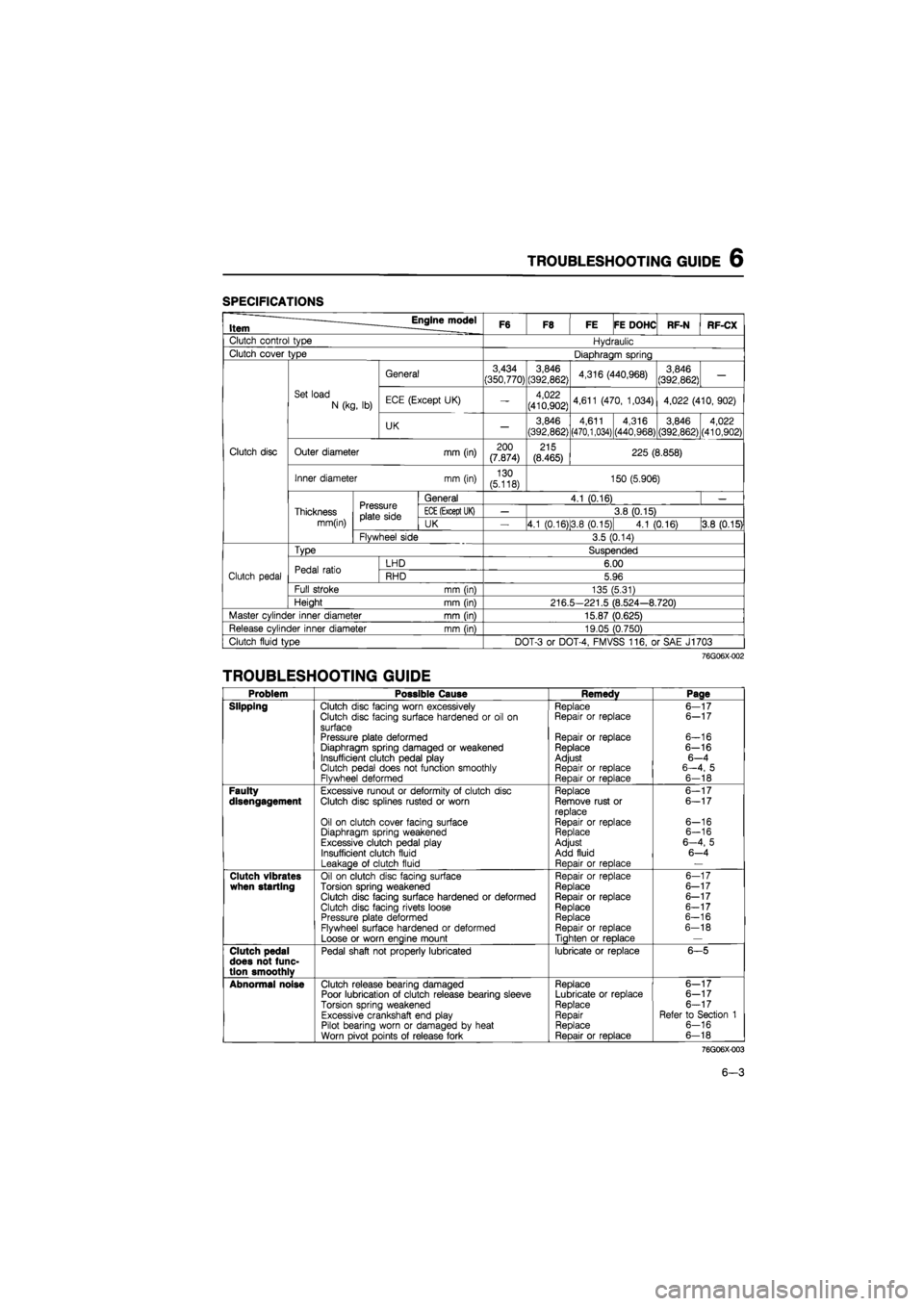
TROUBLESHOOTING GUIDE 6
SPECIFICATIONS
Item Engine model F6 F8 FE FE DOHC RF-N RF-CX
Clutch control type Hydraulic
Clutch cover type Diaphragm spring
General 3,434
(350,770) 3,846
(392,862) 4,316 (440,968) 3,846
(392,862) —
Set load
N (kg, lb) ECE (Except UK) — 4,022
(410,902) 4,611 (470, 1,034) 4,022 (410, 902)
UK — 3,846
(392,862)
4,611 (470,1,034) 4,316
(440,968)
3,846 (392,862) 4,022 (410,902)
Clutch disc Outer diameter mm (in) 200 (7.874) 215 (8.465) 225 (8.858)
Inner diameter mm (in) 130 (5.118) 150 (5.906)
Pressure plate side
General 4.1 (0.16) —
Thickness Pressure plate side
ECE
(Except UK) — 3.8 (0.15)
mm(in)
Pressure plate side UK 4.1 (0.16)13.8 (0.15) 4.1 (0.16) 3.8 (0.15)
Flywheel side 3.5 (0.14)
Type Suspended
Pedal ratio LHD 6.00
Clutch pedal Pedal ratio RHD 5.96
Full stroke mm (in) 135 (5.31)
Height mm (in) 216.5-221.5 (8.524-8.720)
Master cylinder inner diameter mm (in) 15.87 (0.625)
Release cylinder inner diameter mm (in) 19.05 (0.750)
Clutch fluid type DOT-3 or DOT-4, FMVSS 116, or SAE J1703
76G06X-002
TROUBLESHOOTING GUIDE
Problem Possible Cause Remedy Page
Slipping Clutch disc facing worn excessively Replace 6—17 Clutch disc facing surface hardened or oil on Repair or replace 6-17
surface Pressure plate deformed Repair or replace 6-16 Diaphragm spring damaged or weakened Replace 6-16 Insufficient clutch pedal play Adjust 6—4 Clutch pedal does not function smoothly Repair or replace 6—4, 5 Flywheel deformed Repair or replace 6-18
Faulty Excessive runout or deformity of clutch disc Replace 6-17 disengagement Clutch disc splines rusted or worn Remove rust or 6—17 replace Oil on clutch cover facing surface Repair or replace 6-16 Diaphragm spring weakened Replace 6-16
Excessive clutch pedal play Adjust 6—4, 5
Insufficient clutch fluid Add fluid 6-4
Leakage of clutch fluid Reoair or reDlace —
Clutch vibrates Oil on clutch disc facing surface Repair or replace 6-17 when starting Torsion spring weakened Replace 6-17 Clutch disc facing surface hardened or deformed Repair or replace 6-17
Clutch disc facing rivets loose Replace 6-17 Pressure plate deformed Replace 6-16
Flywheel surface hardened or deformed Repair or replace 6-18
Loose or worn engine mount Tighten or replace —
Clutch pedal Pedal shaft not properly lubricated lubricate or replace 6-5 does not func-tion smoothlv
Abnormal noise Clutch release bearing damaged Replace 6—17 Poor lubrication of clutch release bearing sleeve Lubricate or replace 6-17
Torsion spring weakened Replace 6-17
Excessive crankshaft end play Repair Refer to Section 1 Pilot bearing worn or damaged by heat Replace 6-16
Worn pivot points of release fork • Reoair or replace 6-18
76G06X-003
6-3
Page 790 of 1865

6 ON-VEHICLE MAINTENANCE
6-4
ON-VEHICLE MAINTENANCE
FLUID LEVEL
1. Clean the area around the reservoir and the reser-
voir cap.
2. Check the fluid level. If the level is near or below
the "MIN" mark, add clutch fluid to the "MAX"
mark.
Fluid specification:
DOT-3 or DOT-4
(FMVSS 116, or SAE J1703)
PEDAL HEIGHT
Inspection
Measure the distance from the upper center of the
pedal pad to the firewall and ensure that the distance
is within specification.
Pedal height A:
216.5—221.5 mm (8.524—8.720 in)
Adjustment
To adjust the pedal height, loosen locknut and turn
stopper bolt or clutch switch.
PEDAL FREEPLAY
Inspection
Depress the pedal lightly by hand and measure the
freeplay to ensure that it is within specification.
Pedal freeplay: 5—13 mm (0.20—0.51 in)
Adjustment
1. Adjust the free play by loosening locknut C and
turning push rod D.
2. Check that the distance from the floor to the cen-
ter of the upper surface of the pedal pad is as
specified or more when the clutch is fully dis-
engaged.
Disengagement height B:
LHD 68 mm (2.7 in)
RHD 85 mm (3.3 in)
3. Tighten locknut C after adjustment.